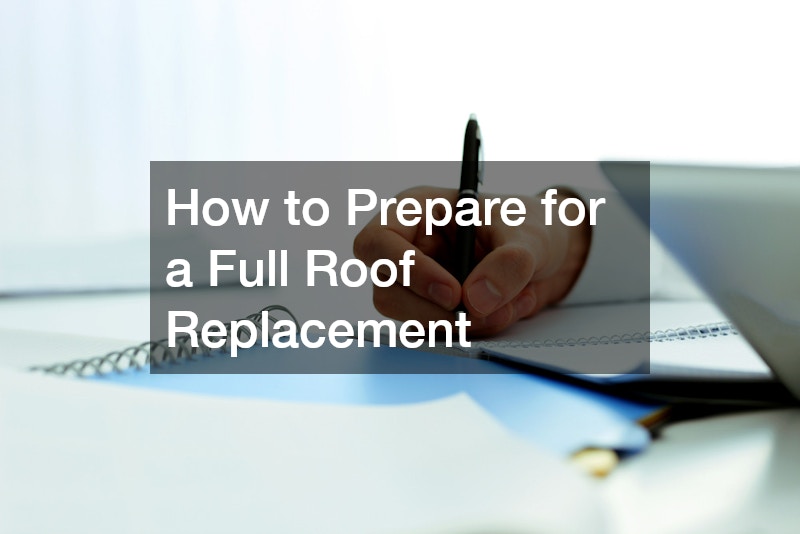
Undertaking a full roof replacement is no small task; it’s a significant investment that demands careful planning, thorough understanding, and effective execution. It’s not just about replacing an old roof with a new one; it’s also about ensuring the longevity, safety, and efficiency of your home. This article aims to provide an in-depth exploration of all aspects related to a full roof replacement, from understanding the process to maintaining your new roof for years to come.
The journey of replacing your roof involves multiple steps, numerous decisions, and the coordination of several services. It’s essential to be well-prepared and knowledgeable about what each step entails, what options are available, and how to manage the entire project efficiently. By understanding these elements, you can ensure a smooth and successful roof replacement experience.
From choosing the right contractor to ensuring proper roof ventilation, this guide covers everything you need to know. Whether you’re dealing with storm damage or simply upgrading for better insulation, the right information can make all the difference. Let’s delve into the detailed aspects of a full roof replacement to help you make informed decisions every step of the way.
Understanding the Re-Roofing Process: What to Expect

The re-roofing process involves several stages, starting with a thorough inspection of your current roof. This inspection helps identify any underlying issues that could affect the new installation. Understanding these issues early on can save time and money in the long run.
Once the inspection is complete, the next step is to choose the type of roofing material that best suits your needs and budget. Various materials, such as asphalt shingles, metal, or tile, each have unique benefits and drawbacks. Selecting the right material is crucial to the longevity and performance of your new roof.
The actual installation process usually involves removing the old roofing material, repairing any damage to the underlying structure, and then installing the new roof. This stage can be noisy and disruptive, so it’s important to prepare your home and family for the temporary inconvenience.
Choosing the Right Local Roofing Contractor for Your Full Roof Replacement

Selecting a local roofing contractor is one of the most critical decisions you’ll make in this process. A reliable contractor can make the difference between a smooth, successful project and a stressful, problematic one. Look for contractors with good reviews, proper licensing, and verifiable experience in full roof replacements.
Requesting quotes from multiple contractors can help you get a sense of the market rate and identify any outliers. Be wary of significantly lower bids, as they could indicate subpar materials or workmanship. Ensure that the contract specifies all aspects of the project, from costs to timelines.
Communication is key in any successful project. Establish clear channels of communication with your contractor to discuss any concerns or changes that may arise. This openness can prevent misunderstandings and ensure that the project stays on track.
Ensuring a Safe Environment: Protecting Your Home and Family During Replacement

A full roof replacement can be hazardous, and taking steps to protect your home and family is essential. Start by removing or covering any valuables that might be affected by dust or debris. This simple step can prevent damage and make the cleanup easier.
Furthermore, clear the areas around your home where contractors will be working. This includes driveways, patios, and walkways. Keeping these areas free from obstacles will not only facilitate a smoother workflow but also minimize the risk of accidents.
Finally, ensure that pets and children are kept away from the work area. The noise and activity can be distressing and dangerous for them. Establish a safe zone where they can stay without coming into contact with the construction area.
How to Communicate with Your Roofing Contractor: Key Questions to Ask

Effective communication with your roofing contractor is crucial for the project’s success. Start by asking about the contractor’s experience with projects similar to yours. Understanding their background can give you confidence in their ability to handle your full roof replacement.
Inquire about the materials they plan to use and why they recommend them. This can help you understand the benefits and potential drawbacks of different options. It’s also an opportunity to discuss the costs and ensure they align with your budget.
Finally, ask about the timeline for the project. Knowing when each phase will be completed helps you plan accordingly and manage any disruptions to your daily life. Regular progress updates can also keep you informed and alleviate any concerns along the way.
Exploring Metal Roofing Suppliers for Durable Replacement Options
When considering a full roof replacement, exploring options from metal roofing suppliers can offer numerous benefits. Metal roofs are known for their durability and long lifespan, often lasting 40-70 years with proper maintenance. This can make them a cost-effective option in the long run.
Additionally, metal roofs provide excellent resistance to extreme weather conditions, including heavy rain, snow, and high winds. This makes them an ideal choice for areas prone to storm damage. Their resilience can provide peace of mind and reduce the need for frequent repairs.
Another advantage of metal roofing is its energy efficiency. Metal roofs reflect solar radiant heat, which can reduce cooling costs by 10-25%. This can make a significant difference in your home’s overall energy consumption and contribute to a more sustainable living environment.
Assessing Storm Damage: When to Consider a Full Roof Replacement
Storm damage can be a key factor in deciding whether to undertake a full roof replacement. After a severe storm, it’s important to conduct a thorough inspection of your roof to assess any visible damage. Look for signs such as missing shingles, dents, or cracked tiles, which indicate the need for repair or replacement.
Beyond visible damage, also consider the less obvious effects of storm damage. Water infiltration can lead to mold growth and structural damage over time. Using mold detectors can help identify any hidden mold issues that need to be addressed during the replacement process.
If the damage is extensive, affecting a large portion of the roof, a full roof replacement may be more cost-effective than multiple repairs. Consulting with a professional roofing contractor can provide a clearer assessment and guidance on the best course of action.
The Importance of Roof Coatings: Enhancing Longevity After Replacement
Investing in roof coatings can significantly enhance the longevity and performance of your new roof. Roof coatings act as a protective layer, shielding the roof from UV rays, moisture, and other environmental factors. This can prevent premature aging and degradation of the roofing material.
Moreover, roof coatings can improve the energy efficiency of your home by reflecting more sunlight and reducing heat absorption. This can lead to lower cooling costs and a more comfortable indoor environment. Various types of coatings are available, each with its unique properties and benefits.
Regularly applying roof coatings as part of your roof maintenance routine can also minimize the need for frequent repairs. Discussing the best coating options with your roofing contractor can ensure that you choose a product that complements your roofing material and meets your specific needs.
Using Mold Detectors to Ensure a Healthy Environment Before and After
Mold growth can be a significant concern both before and after a full roof replacement. Water damage, often unseen, can lead to mold proliferation, which poses health risks to residents. Using mold detectors is an effective way to identify the presence of mold and address it promptly.
Before starting the roof replacement, conduct a mold inspection using detectors. This helps ensure that any existing mold issues are resolved before new roofing materials are installed. Addressing these issues early can prevent further damage and health risks.
After the new roof is installed, continue to monitor for mold, especially after heavy rainfall or storms. Regular checks with mold detectors can catch potential problems early, allowing for timely intervention and maintaining a healthy living environment.
How Your Chimney May Affect Your Roof Replacement Plans
Your chimney can significantly impact the logistics and planning of your full roof replacement. Chimneys are integrated with the roofing system, and any issues with the chimney can affect the overall integrity of your roof. It’s important to include chimney inspection and repair as part of your replacement plans.
If your chimney has structural issues or is in need of repairs, addressing these during the roof replacement is more efficient. Chimney repair can be coordinated with the roofing work, ensuring both systems are properly integrated and sealed to prevent leaks.
Additionally, consider the type of chimney you have, whether brick masonry or prefabricated, as this can influence the replacement process. Ensuring that your chimney and new roofing system are compatible and properly installed can enhance the overall durability and performance of your roof.
Evaluating Insulation Services: Improving Energy Efficiency Post-Replacement
Upgrading your insulation during a full roof replacement can significantly improve your home’s energy efficiency. Proper insulation helps maintain a consistent indoor temperature, reducing the need for heating and cooling. This can lead to considerable savings on energy bills.
Insulation services can identify gaps or areas where the current insulation may be lacking. Enhancing these areas during the roof replacement ensures that your home’s thermal barrier is as effective as possible. This proactive approach can prevent heat loss in winter and keep your home cooler in summer.
Discussing insulation options with your roofing contractor can provide insights into the best materials and techniques for your specific situation. Combining a new roof with improved insulation creates a more energy-efficient home, contributing to both comfort and cost savings.
The Role of Roof Ventilation in Your Full Roof Replacement Preparation
Roof ventilation plays a crucial role in the health and longevity of your roofing system. Adequate ventilation helps regulate temperature and moisture levels in the attic, preventing problems such as ice dams in winter and overheating in summer. Ensuring proper ventilation should be a key aspect of your full roof replacement preparation.
Without sufficient ventilation, excess heat and moisture can build up, leading to potential damage to the roofing materials and underlying structure. This can shorten the lifespan of your new roof and result in costly repairs down the line. Discussing ventilation solutions with your roofing contractor can help address any existing issues.
Incorporating ventilation enhancements during the roof replacement process ensures that your new roof performs optimally. Techniques such as ridge vents, soffit vents, and attic fans can be utilized to improve air circulation. Proper ventilation contributes to a more durable, efficient roofing system.
Steps to Take to Extend the Life of Your New Installation
Maintaining your new roof is essential for extending its lifespan and protecting your investment. Regular inspections, ideally twice a year, can help identify and address minor issues before they escalate. This proactive approach can prevent costly repairs and prolong the life of your roof.
Cleaning your roof is another crucial step. Using a roof pressure washer or hiring professional cleaning services can remove debris, moss, and algae that can degrade roofing materials over time. Keeping your roof clean ensures that it remains in good condition and performs efficiently.
Additionally, addressing any necessary repairs promptly can prevent small problems from becoming major issues. Regular maintenance, including checking for loose or damaged shingles and ensuring proper drainage, can significantly extend the life of your roof. These steps, combined with quality materials and professional installation, can provide long-term protection for your home.
Undertaking a full roof replacement is a comprehensive process that requires careful planning and execution. From understanding the stages of re-roofing to choosing the right materials and contractors, each decision plays a crucial role in the success and longevity of your new roof. Protecting your home and family during the replacement, exploring metal roofing options, and ensuring proper ventilation and insulation are all key factors to consider.
By staying informed and proactive throughout the process, you can ensure that your full roof replacement meets your needs and enhances your home’s value and efficiency. Ongoing maintenance, such as regular inspections and cleaning, further contributes to the durability and performance of your new roof. With the right approach and professional guidance, you can achieve a successful and long-lasting roof replacement.
Whether you’re addressing storm damage or simply upgrading for better energy efficiency, a well-executed roof replacement can provide peace of mind and long-term benefits. This guide aims to equip you with the knowledge and insights needed to navigate the complexities of roofing projects, ensuring a smooth and successful outcome.


